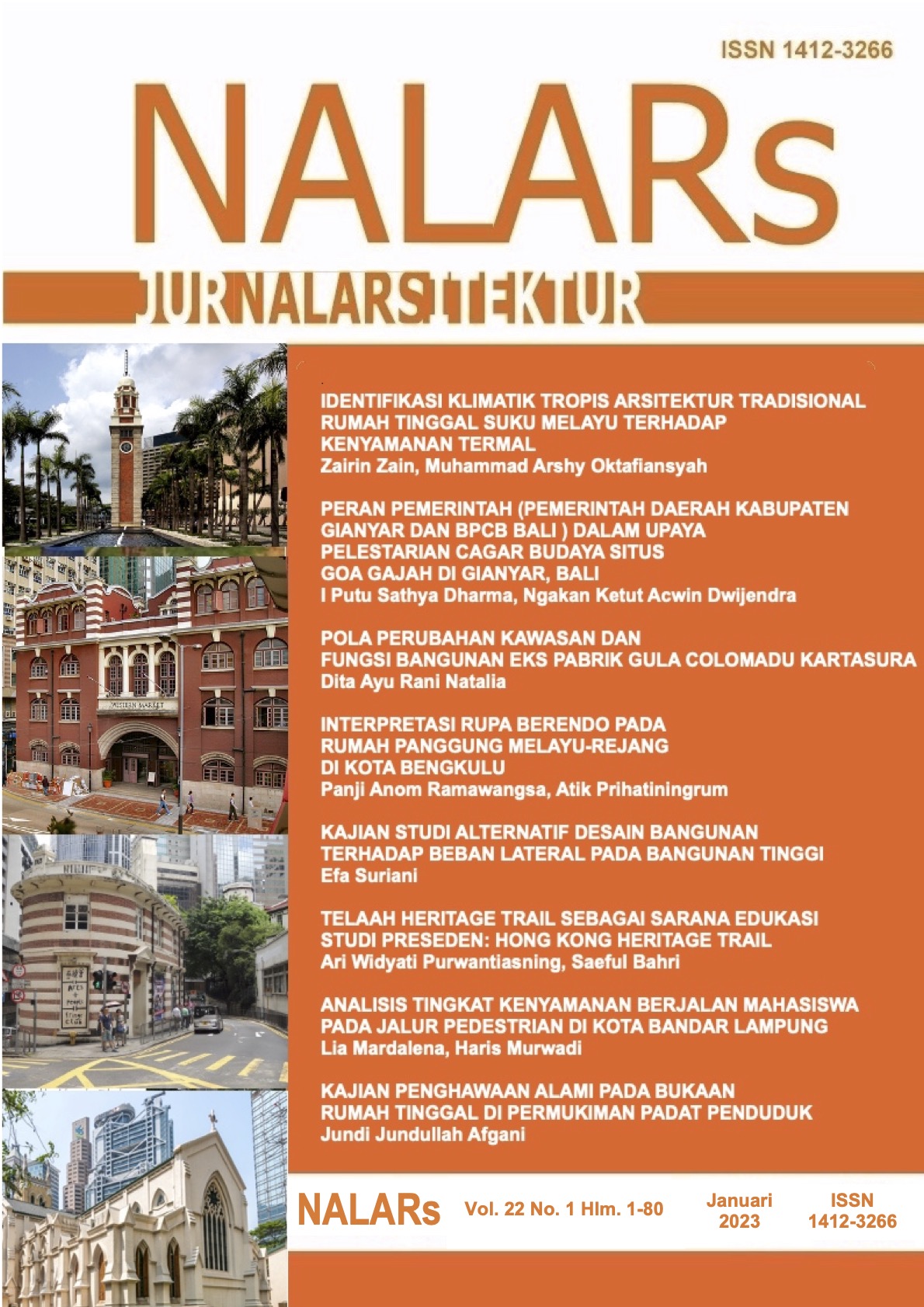INTERPRETASI RUPA BERENDO PADA RUMAH PANGGUNG MELAYU – REJANG DI KOTA BENGKULU
DOI:
https://doi.org/10.24853/nalars.22.1.27-34Abstract
ABSTRAK. Rumah menjadi kebutuhan primer sebagai tempat berlindung serta membina dalam keluarga. Mayoritas rumah panggung Melayu-Rejang di kota Bengkulu memiliki teras dengan nama lokal yaitu berendo. Berendo difungsikan sebagai tempat interaksi penghuni rumah dengan tetangga sekitar serta bersifat multifungsi untuk kegiatan lain yang dibutuhkan oleh pemilik rumah. Tujuan penelitian ini adalah menjadi pengembangan pendidikan budaya lokal di Bengkulu terutama pengetahuan arsitektur nusantara yang telah bertahan eksistensinya hingga sekarang. Metode yang digunakan adalah deskriptif analisis dengan cara observasi di kota Bengkulu. Pengumpulan data menggunakan alat Geographic Information System (GIS) untuk mendapatkan informasi yang akan dituangkan ke dalam bentuk peta. Hasil penelitian ini didapatkan yaitu jumlah berendo panggung kombinasi kayu dan beton tipe 1 sebanyak 15 unit rumah, berendo panggung kombinasi kayu dan beton tipe 1 sebanyak 47 unit rumah, berendo panggung kayu dengan tangga tengah sebanyak 21 unit, berendo panggung kombinasi kayu dan beton tipe 3 sebanyak 29 unit rumah, berendo panggung kombinasi kayu dan beton tipe 4 sebanyak 30 unit rumah, berendo panggung kayu sebanyak 18 unit rumah. Kesimpulan di dapat yaitu rupa bentuk berendo di rumah panggung Melayu-Rejang kota Bengkulu memiliki aneka ragam bentuk yang dipengaruhi oleh minat dan keinginan oleh pemilik rumah. Kata kunci: Bengkulu, berendo, Melayu – Rejang, vernakular ABSTRACT. The house is a primary need for shelter and fostering in the family. Most Malay-Rejang stilt houses in Bengkulu city have a terrace with a local name, namely Berendo. Berendo functioned as a place of interaction between residents of the house with neighbors and is multifunctional for other activities needed by the homeowner. This research aims to develop local cultural education in Bengkulu, especially knowledge of archipelago architecture, which has survived its existence until now. The method used is a descriptive analysis using observation in the city of Bengkulu, collecting data using Geographic Information System (GIS) tools to obtain information that will be poured into map form. The results of this study received the number of stage combinations of wood and concrete type 1 as many as 15 units of houses, stage combinations of wood and concrete type 1 as many as 47 units of houses, as many as 21 units of wooden stilts with a central staircase, stage combinations of wood and concrete type 3 as many as 29 units of houses, 30 units of wooden and concrete stilt combinations of type 4, 18 units of wooden stilts. The conclusion obtained is that the shape of the Berendo in the Malay-Rejang stilt house in Bengkulu city has various forms which are influenced by the interests and desires of the homeowner. Keywords: Bengkulu, berendo, Melayu – Rejang, vernacularDownloads
Published
2023-01-09
Issue
Section
Articles


